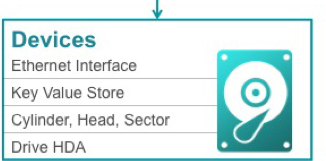It’s not time to say goodbye to the old storage network quite yet, but a new combination of cloud, networking, and storage technology might mark the beginning of the end for SANs—Seagate has introduced a new storage architecture that puts Ethernet directly on the disk drive.
Called the Kinetic Open Storage Platform, the new approach turns disks themselves into servers, delivering data over the network to applications using an open application interface. The Kinetic platform is a combination of an open programming interface and intelligence and a network interface installed in the storage device itself. It's targeted mostly at companies looking to adopt the same sort of architecture in their data centers that they use to connect to cloud storage providers such as Amazon.
While the architectural approach Seagate is taking is an evolution of work already done by cloud giants such as Google and Facebook, it turns cloud-style storage into a commodity. And that could change how companies small and large think of networked storage—especially as they move toward using newer software development approaches to build their applications or move applications built on Amazon or other cloud services back within their firewalls.

Kinetic uses the same sort of key-value pair approach pioneered by Google's distributed file system. The storage devices expose data as objects that abstract the physical blocks that data is stored in, without the overhead of a file system's directory structure. Applications don't need to go through an operating system's storage drivers to manipulate data—they simply send "get," "put," and "delete" requests to the storage system.
While this eliminates doing things like appending files, it allows for storage systems to be easily scaled up with the addition of more disks—there's no need to recreate a directory structure or remap storage blocks. It also eliminates the overhead associated with traditional storage area networks (SANs), where operating system calls for disk reads and writes can consume much of the bandwidth of the network.
Cutting out the middle man

Amazon uses the same sort of interface for its Simple Storage Service (S3), as do "big data" systems such as Hadoop and NoSQL databases such as Basho's Riak and MongoDB. But those other key-value, pair-based systems generally run atop operating systems and rely on servers to manage data.
Kinetic eliminates the server entirely, with all of the management being handled by the storage devices. Each Kinetic drive or SSD has its own key-value management logic, and the drives can communicate with each other to handle replication or movement of data. Seagate is publishing the application library developers will use to control these storage systems as open source.
Others have seen the benefit of moving intelligence further down toward the storage device itself for cloud applications. Facebook has been developing a similar storage model for its data centers using a "micro-server" in its Open Vault storage nodes.
Seagate's Kinetic is the first commercial product to take this step. But it probably won't be the last. While traditional SANs aren't exactly on the endangered species list, the continued shift toward cloud-based development for both large-scale and smaller applications is going to make Kinetic increasingly attractive to both big data center operators and smaller organizations looking to create their own internal cloud storage without tethering themselves to Amazon or Microsoft.
Listing image by Seagate
reader comments
67